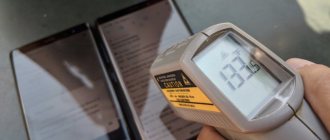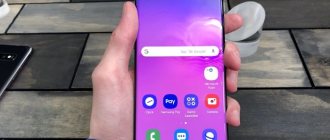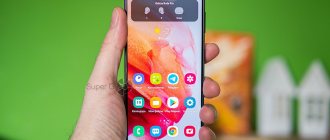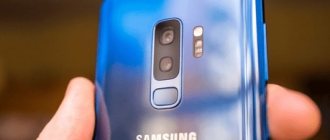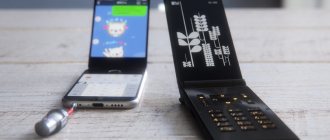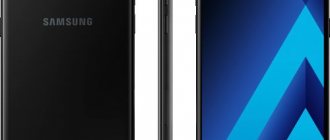Korean monster of autonomy
Samsung has released the Galaxy F62 smartphone with a battery capacity larger than that of any Xiaomi mobile phone and a processor shared with the Galaxy Note 10, the flagship of the 2022 model year. Samsung attributes its new product to the middle segment, and it premiered in India.
At the time of publication of the material, Samsung’s plans to release the Galaxy F62 in Russia were not known. Its F-series smartphones are not officially sold in Russian retail, and buyers have to choose between devices from the Note, M, A, Z and S lines.
In India, the recommended price of the Galaxy F62, available in black, blue and green shades, starts from 24,000 rupees ($330, 24.4 thousand rubles at the Central Bank exchange rate as of February 15, 2022), for the version with 6 GB of RAM and 128 GB permanent memory. If you pay 26,000 rupees ($357, 26.4 thousand rubles), you can purchase an 8/128 GB modification.
Samsung Galaxy F62
The start of sales of the smartphone is scheduled for February 22, 2022, but for now Samsung is accepting pre-orders for it.
Previous generation Samsung Galaxy M 2022
Only the above two smartphones were updated. But such models as Samsung Galaxy M01, M21, M51, M31S remained without updates and are no longer considered relevant. The same applies to M11 and M31. However they are still interesting.
But it is worth noting that in terms of technical characteristics and some other indicators, they cannot be compared with the new generations of M line devices. Therefore, if you need a truly up-to-date smartphone, you should not pay attention to outdated versions.
Battery like two iPhones
Samsung installed a 7000 mAh battery in the new Galaxy F62. For the company, it became the second smartphone with a battery of such capacity - the first was the Galaxy M51, which went on sale in Europe in early September 2022 at a price of 360 euros (32.03 thousand rubles). In Russia, the M51 currently costs 33 thousand rubles for 6/128 GB, that is, it is much more expensive than the Galaxy F62, and it has only two available body colors - black and white.
Galaxy F62 review
Compared to the vast majority of modern smartphones, especially the top segment, the battery capacity of the new Galaxy F62 is several times higher. For comparison, the flagship Apple iPhone 12 Pro Max costs in Russia from 110 thousand rubles. Powered by a 3687 mAh battery. Only third-tier smartphones can compare with the Galaxy F62 - for example, in February 2022, the Doogee S86 monoblock with an 8500 mAh battery appeared in Russia.
Galaxy M51, another Samsung smartphone with a 7000 mAh battery
Galaxy F62 supports fast charging via USB-C. A 25W charger is included in the package. Wireless charging is not provided in this smartphone.
Screens of new smartphones of the Samsung Galaxy M line
The most affordable model M12 has a PLS matrix screen with a diagonal of 6.50 inches. The color rendition is quite flagship. Like resolution and pixel density. All information is displayed extremely clearly.
The M32 variant is equipped with a 6.40-inch SuperAMOLED display. This allows you to display the image with the highest quality possible. At the same time, the display refresh rate is 90 Hz, which is quite normal for phones of this level.
Processor and display
The screen of the Samsung Galaxy F62, despite the fact that it is a mid-range smartphone, is characterized by visually thin frames. Its diagonal is 6.7 inches, and it is a Super AMOLED panel with a round cutout for the front camera. Maximum screen brightness is 420 nits, supported resolution is Full HD+ or 2400x1080 pixels. The matrix is covered with reinforced Gorilla Glass, which, as practice shows, protects from impacts but is resistant to scratches, but there is no protective film included in the package, nor is there a basic silicone case.
The screen, like the processor, is modern for the Galaxy F62
The basis of the new smartphone is the Exynos 9825 processor - Samsung's first mobile chip made according to 7-nanometer standards. The company announced it in August 2022 and used it in the top-end business-class mobile phone Galaxy Note 10.
Anton Pletnev, Cherkizovo: The implementation of information security solutions in retail directly leads to a reduction in damage from cyber attacks
Business
The Exynos 9825 has eight cores (two Samsung's own cores, two Cortex-A75 cores and four Cortex-A55 cores) and a Mali-G76 MP12 video card with 12 cores. There is an NPU (Neural Processing Unit) neurocomputing module and an LTE-Advanced Pro Cat.20 modem with download speeds of up to 2 Gbit/s. All this is complemented by LPDDR4X RAM controllers and built-in UFS 3.0 and UFS 2.1. The processor clock frequency is from 1.9 to 2.7 GHz.
Detailed technical specifications
Make and model
Make and model of the device, and alternative names (if any).
| Brand Device manufacturer company. | Samsung |
| Model Device name. | Galaxy M62 |
| Alternative names Other model names, if available. Sometimes the model is called differently, depending on the country or because of popular nicknames. | SM-E625F SM-E625F/DS |
Design
Appearance of the device including dimensions, weight, volume, colors and materials.
| Width The horizontal side of the device when used in standard orientation. | 76.3 mm (millimeters) |
| Height The vertical side of the device when used in standard orientation. | 163.9 mm (millimeters) |
| Thickness The cross-sectional size of the device. | 9.5 mm (millimeters) |
| Weight How much does the device weigh excluding the case, SIM and memory cards and other additional elements. | 218 g (grams) |
| Volume Approximate value calculated using the formula: length times width times height. | 118.8 cm³ (cubic centimeters) |
| Colors What colors is the device available in? | Laser Green Laser Gray Laser Blue |
| Housing materials What materials is the body made of? | Plastic |
System on a Chip (SoC)
A system on a chip, a single-chip system (System on a Chip, SoC) is when several systems performing different device functions are connected on one chip.
| System on a Chip (SoC) A single-chip system that contains components such as a processor, graphics accelerator, memory units, communication interfaces, etc., as well as software for the operation of the system. | Samsung Exynos 9 9825 |
Central processing unit (CPU)
| Central processing unit (CPU) The main component of the device is responsible for calculations and data processing. | 2x 2.73 GHz Exynos M4, 2x 2.4 GHz ARM Cortex-A75, 4x 1.95 GHz ARM Cortex-A55 |
| Technical process What technological process is used to make the chip? The smaller the process technology, the better - the chips consume less power and generate less heat. | 7 nm (nanometers) |
| Processor size Processor capacity is a parameter that indicates how many bits of data a processor register processes in 1 clock cycle. This is usually 32 or 64 bits. | 64 bit |
| Instruction Set Architecture Instruction set architecture (ISA) is a programmable part of the microprocessor core used by software to control the operation of the processor. | ARMv8.2-A |
| Number of processor cores The processor can be either single-core or multi-core. The performance of the processor depends on the number of cores (threads). The more cores working simultaneously, the higher the power consumption, so in mobile devices all cores are used only under high load. | 8 |
| CPU clock speed Clock speed is the number of operations per second that a processor or its core can achieve. The higher the frequency, the higher the overall performance of the device, but performance also depends on the processor architecture and the number of cores. | 2730 MHz (megahertz) |
Graphics Processing Unit (GPU)
| Graphics Processing Unit (GPU) The graphics processing unit (GPU) is used to process and display graphics - 3D effects, games, interfaces and other visual elements. Due to the pipeline architecture, the GPU is many times more efficient in graphics processing than the processor. | ARM Mali-G76 MP12 |
Random access memory (RAM)
| Amount of random access memory (RAM) RAM (Random Access Memory, RAM, RAM) is temporary memory (works only while the device is running), which stores data and code for the operational operation of programs and applications. The more RAM, the more programs you can run simultaneously without loss of performance (there will be fewer “brakes”). | 6 GB (gigabytes) 8 GB (gigabytes) |
| Type of random access memory (RAM) Information about the type of RAM used by the device. | LPDDR4X |
| Number of RAM channels 1 is a single-channel RAM operating mode, basic, when 1 memory module is used. 2 is already a two-channel mode - a mode of parallel operation of 2 modules or pairs of modules, memory channels - this mode is 2 times faster than a single-channel one. 3 – three-channel mode is 3 times faster than single-channel mode. | Dual channel |
Built-in memory
Most mobile devices have built-in Flash memory, which is used as a storage for system data, the operating system, as well as user data - photos, videos, recordings and much more.
| Built-in memory capacity The higher the amount of built-in memory, the more games, programs, music, videos and your other files will fit in the device, especially the amount of memory is important when the device does not support memory cards. | 128 GB (gigabytes) |
Operating system
A mobile operating system (OS) is pre-installed software with a well-thought-out interface for user control of device functions.
| Operating system (OS) The operating system installed by default by the device manufacturer, as well as its version. | Android 11 |
| User interface User interface (UI - user interface) is usually a graphical shell that ensures the transfer of information between the user and the operating system. | OneUI 3.1 |
Battery
To operate autonomously, a mobile device requires a battery that powers all its components.
| Battery capacity The main characteristic of a battery is its maximum capacity, that is, the charge it can store. Capacity is measured in mAh (mAh, milliamp-hour). The higher the capacity, the longer the mobile device can work. | 7000 mAh (milliamp-hours) |
| Battery type Many types of batteries have been used in portable devices, but NiCd (nickel-cadmium), NiMH (nickel-metal hydride), and even more so SLA (lead-acid) batteries are already considered obsolete. Instead, modern mobile devices use Li-Ion (lithium-ion) and Li-Pol, Li-Poly (lithium-polymer) batteries. | Li-Ion (Lithium-ion) |
| Power adapter Characteristics of the charger (adapter, power supply) included in the standard package of the mobile device. More precisely, the output voltage in volts (V) and the output current in amperes (A). | 5 V (volts) / 5 A (amps) |
| Fast charging Fast charging is when the device charges very quickly. For example, up to 50-70% of a full battery charge in ten minutes. | Yes |
Screen
The screen (display) is the main element for displaying graphic information.
| Technology The technology used to make the screen. There are many types of display manufacturing with their pros and cons. | Super AMOLED |
| Diagonal The screen diagonal of a device is measured in inches (inch, in or simply ″), and 1″ is equal to 2.54 cm. | 6.7 in (inches) 170.18 mm (millimeters) 17.02 cm (centimeters) |
| Width Approximate screen width | 69.84 mm (millimeters) 6.98 cm (centimeters) |
| Height Approximate screen height | 155.19 mm (millimeters) 15.52 cm (centimeters) |
| Aspect Ratio Aspect ratio is the ratio of the shorter side of the screen, which is considered to be 1, to the longer side, which is denoted by a decimal fraction indicating the ratio to the short side. | 2.222:1 |
| Screen resolution Screen resolution is the number of horizontal pixels (dots) multiplied by the number of vertical pixels. The higher the resolution, the more detailed the image will be. | 1080 x 2400 pixels |
| Pixel Density The number of pixels per inch or PPI (pixels per inch) indicates the density of pixels per 1 inch (2.54 cm) of the screen. The higher the PPI, the sharper the image, and the less visible or even invisible “squares and dots” (pixels). | 393 ppi (pixels per inch) 154 ppcm (pixels per centimeter) |
| Color depth Color depth means how many bits are used in 1 pixel to display color (bits per pixel). | 24 bit 16777216 colors |
| Screen area Approximate usable area occupied by the screen on the front of the device. The higher the percentage, the narrower the frames around the display or the smaller the “chin with bangs.” | 86.94% (percent) |
| Touch screen A touch screen is a device that usually covers the display and is a touch input tool. In fact, in mobile devices, the touchscreen is a replacement for the keyboard and mouse. | Yes |
| Touch screen type There are many types of touch screens, with their pros and cons. Mobile devices often use capacitive touchscreens, but technology does not stand still and new types of sensors are appearing. | Capacitive |
| Multi-touch Touch screen support for two or more touches. For example, zooming photos with two fingers. | Yes |
| Impact-resistant protective glass of the display The screen and touchscreen of a mobile device are usually covered with protective tempered glass (sometimes plastic or film is used instead of glass) to protect the display from impacts and scratches. Many companies are engaged in the production of such protection, but the most famous are Corning - Gorilla Glass and Asahi - Dragontrail. | Yes |
| Brightness Screen brightness is measured in candelas per square meter (cd/m2, cd/m2). The higher this indicator, the brighter the screen luminosity will be and the less it will be affected by ambient lighting. Comfortable brightness for videos and games is considered to be 300 cd/m2 or more. | 420 cd/m² |
Main camera
The main camera, usually built into the rear of the device, is designed for creating photo and video content.
| Maximum image resolution This is the maximum number of pixels (dots) horizontally and vertically. The higher the resolution, the more detailed the image will be. Resolution can also be indicated in megapixels - this is the total number of pixels that can be in the image, calculated by the formula: vertical pixels multiplied by the number of horizontal pixels and divide the resulting amount by 1 million. | 9280 x 6920 pixels 64.22 MP (megapixels) |
| Matrix pixel size Pixel size is one of the matrix parameters that determines what size pixels are used in the matrix. The larger the size, the better - less noise and a larger light-sensitive area. | 0.8 µm (micrometers) 0.000800 mm (millimeters) |
| Diaphragm Aperture (f-number, f) is used to control the light flux passing through the lens. The aperture is indicated by a fraction, and the smaller the fractional number, the higher the aperture passing through the lens. The more light that passes through the lens, the better overall, less noise in your photos and better night photography. | f/2 |
| Flash type Most mobile devices are equipped with light-emitting diode (LED) flashes, but there are also xenon flashes. As a flash, xenon is better - it is more powerful, but LED is more versatile (can work as a flashlight) and consumes less electricity. | LED |
| Number of lenses in the lens This is the number of optical elements (lenses) that are contained in the optical circuit of a camera lens. | 6 |
| Maximum video resolution This is the maximum number of pixels (dots) horizontally and vertically. The higher the resolution, the more detailed the image will be. | 1920 x 1080 pixels 2.07 MP (megapixels) |
| FPS video recording at maximum resolution FPS (Frames per Second, frame rate) is the number of frames that changes in 1 second. The higher the number of frames per second, the smoother the image will be. In this case, we mean the number of frames that the camera can achieve at its maximum resolution; the lower the resolution, the higher the FPS can be. | 30 fps (frames per second) |
| Presence of flash Incorporating a flash into a mobile device allows you to take pictures in low light conditions. Creates the necessary lighting and compensates for the lack of natural light. | Yes |
| Digital zoom With digital zoom (zoom, enlargement), the subject is brought closer due to software image algorithms. The higher the magnification with digital zoom, the worse the image quality (noise, blur) will be compared to a non-zoomed one. | Yes |
| Focus on face Function of auto-detection of living objects and autofocus on their face or head. | Yes |
| Panoramic shooting mode Panoramic photography is a series of frames where each subsequent frame is a continuation of the previous one; at the end of the shooting, all frames are stitched together at the software level to create a panoramic photograph. Frames can be shot both vertically and horizontally, and their width can be up to 360 degrees. This type of shooting is used when the camera's viewing angle is not enough to capture the entire scene. | Yes |
| HDR shooting mode HDR photography takes a quick series of shots with highlights, midtones, and shadows, then combines them into a single frame with high dynamic range. | Yes |
| Electronic (digital) image stabilizer EIS (Electronic Image Stabilizer - digital image stabilization) is performed using software algorithms and is needed to reduce blurring when the camera shakes. | Yes |
| White balance White balance is a setting that helps ensure the correct color reproduction in an image by determining the color temperature of the light source in the frame. The balance can be set either automatically or manually. | Yes |
| ISO Setting ISO is the level of light sensitivity. The lower the ISO, the less sensitive the camera's light sensor and the smoother the image with less noise. The higher the ISO, the higher the light sensitivity, but more noise, graininess, or decreased sharpness. | Yes |
| Additional Information Additional information about the functions and characteristics of cameras. | Autofocus Continuous shooting Geo-tagging Touch focus Exposure compensation Self-timer Scene selection mode Phase detection autofocus (PDAF) |
Additional cameras
Secondary cameras allow you to expand the capabilities of the main camera, such as adding a wide shooting angle, sharpness, optical zoom and other functions depending on the type of secondary camera.
| Second additional camera | 5 MP (megapixels) |
| Third additional camera | 12 MP (megapixels) |
Front-camera
The front camera of a mobile device (selfie camera, rear camera) is a camera on the front part, which is usually used for video communication, recognition of gestures or faces, and selfie photographs.
| Photo resolution The maximum image resolution that the camera can produce. As resolution increases, image detail increases. Resolution can also be indicated in megapixels (the total number of pixels that an image can consist of) - these are vertical pixels multiplied by horizontal pixels and divided by 1 million. | 32 MP (megapixels) |
| Matrix type There are not many types of matrices, the main ones are CCD, PureCel and the most popular in mobile devices due to low power consumption and compact size - CMOS. | CMOS (complementary metal-oxide semiconductor) |
| Video resolution This is the maximum resolution the camera can record video at. The higher the resolution, the better. | 1920 x 1080 pixels 2.07 MP (megapixels) |
| Frame rate (FPS) of video shooting This is talking about FPS at maximum video resolution; at lower resolutions, the frame rate per second can be higher. FPS determines the smoothness of the video, as well as the ability to speed up or slow down it. | 30 fps (frames per second) |
| Face unlock This is a new way to unlock your phone using facial recognition | Yes |
| Additional Information Additional information about the functions and characteristics of cameras. | HDR shooting |
Memory card
A memory card (flash card) is an external data storage device that is used in many devices to increase memory capacity.
| Memory card type and formats Mobile devices usually use 3 types of memory cards - SD, miniSD and the most common microSD. Each type has its own formats that the device supports. | microSD microSDHC microSDXC |
SIM card
Subscriber Identification Module (SIM) used in mobile devices to identify subscribers in cellular networks.
| Type, size of SIM card A regular (mini SIM) card has dimensions of 25x15 mm. Micro SIM - 15x12 mm. Nano SIM - 12.3x8.8 mm. The sizes of SIM cards are different and not interchangeable. There is also an eSIM (virtual, electronic SIM card), it is built into the device and does not take up space. | Nano-SIM (4FF - fourth form factor, since 2012, 12.30 x 8.80 x 0.67 mm) |
| Number of SIM cards How many SIM cards does the device support? | 2 |
| Additionally Additional information about the operation of SIM cards in the device. | Dual SIM stand-by (Both cards are active. When one is busy talking, the other is deactivated.) |
Mobile networks
This is a system in which communication and data transfer is carried out between subscribers, the location of one or more of which changes. This section lists the supported mobile communication standards and frequencies.
| GSM GSM (Global System for Mobile Communications) is a standard for digital mobile cellular communications of the second generation 2G with time and frequency division of channels. GSM came to replace analog cellular communications 1G (first generation). | GSM 850 MHz (B5) GSM 900 MHz (B8) GSM 1800 MHz (B3) GSM 1900 MHz (B2) |
| UMTS UMTS (Universal Mobile Telecommunications System), also called 3GSM, is a third generation (3G) mobile communications standard based on the WCDMA air interface. | UMTS 850 MHz (B5) UMTS 900 MHz (B8) UMTS 1900 MHz (B2) UMTS 2100 MHz (B1) |
| LTE LTE (Long-Term Evolution, often referred to as 4G LTE) is a standard for wireless high-speed data transmission, which, although it belongs to fourth generation networks (4G), is essentially a transitional stage from 3G to 4G, greatly accelerating data transfer speeds. The standard has an improved version, LTE Advanced (LTE-A), which can already be considered a full-fledged 4th generation network. | LTE-FDD 850 MHz (B5) LTE-FDD 900 MHz (B8) LTE-FDD 1800 MHz (B3) LTE-FDD 2100 MHz (B1) LTE-FDD 2600 MHz (B7) |
Mobile network data standards
What data transfer standards in cellular networks are supported by the device, as well as their speed.
| Data transmission technologies Technologies for receiving and transmitting data, as well as their maximum speed. | UMTS (384 kbit/s) EDGE GPRS HSPA+ (HSUPA 5.76 Mbit/s, HSDPA 42 Mbit/s) LTE |
WiFi
Wi-Fi (Wireless Fidelity) is a technology for wireless data transmission over a local network among devices based on IEEE 802.11 standards.
| Wi-Fi Direct support The Wi-Fi Direct protocol allows multiple devices to connect directly, bypassing the use of routers or access points. | Yes |
| Wi-Fi Hot-Spot A hotspot is a Wi-Fi access point. In a mobile device, Hot-Spot turns the smartphone into a Wi-Fi access point, essentially turning it into a router capable of distributing the Internet. | Yes |
| Dual-band Wi-Fi DUAL-BAND (dual-band) Wi-Fi is the ability of a device to immediately receive or broadcast wireless signals in two frequency bands 2.4 and 5 GHz. 5GHz is a less congested frequency, due to which the connection will be of better quality. | Yes |
| WiFi Supported WIFI wireless network standards. | 802.11a (IEEE 802.11a-1999) 802.11b (IEEE 802.11b-1999) 802.11g (IEEE 802.11g-2003) 802.11n (IEEE 802.11n-2009) 802.11n 5GHz 802.11ac (IEEE 802.11ac) Wi-Fi Display |
Bluetooth
Bluetooth (BT, bluetooth (z), “blue tooth”) is a short-range wireless network (up to 10, sometimes 100 meters) operating on radio waves to transmit voice and data between devices.
| Bluetooth version Bluetooth technology is actively developing and, since 1998, has been constantly updating versions of the standard. Each subsequent version introduces one or several improvements in data exchange speed, range, facilitates pairing, reduces power consumption, or introduces some new protocols and operating profiles. The higher the Bluetooth version, the better. The technology is also backward compatible, for example, if your mobile device has version 5.0, then it will work with accessories version 4.2 and lower, but the improvements introduced in version 5.0 will not work; they will work only if both the device and accessories are version 5. | 5.0 |
| A2DP profile The A2DP Bluetooth profile is designed to transmit a high-quality two-channel stereo signal via Bluetooth to wireless headphones, speakers and other acoustics. | Yes |
Sensors
Modern devices have many sensors that help in measurements, trigger functions, and make using the device more pleasant.
| Light sensor The light sensor reacts to the light level and is able to adjust the screen brightness automatically based on this. This is necessary to reduce power consumption and ease of use of the device. | Yes |
| Proximity sensor The proximity sensor reacts to the proximity of the mobile device to some object. For example, the sensor is used when talking on the phone to turn off the screen, which saves energy and prevents you from pressing buttons with your ear or cheek. | Yes |
| Gyroscope Gyroscope (gyroscope, gyro sensor) is a sensor for orientation in space that tracks the angle of inclination of even a stationary device along three coordinate axes. The sensor is mainly used in conjunction with an accelerometer in games and applications. | Yes |
| Accelerometer An accelerometer is a sensor that measures apparent acceleration, that is, it determines the position and distance at which a mobile device moves in space. Based on the data from this sensor, the screen orientation change, pedometer, control using tilts and gestures in games and applications, etc. work. | Yes |
| Fingerprint's scanner The scanner is responsible for authorization using a previously saved fingerprint, as a result of which the device is unlocked, payment is made, some action is confirmed - just put your finger on the scanner. Scanners can be either built into the body or built into a button or screen. | Yes |
| Digital compass This is software that displays data from a magnetic sensor or GPS in the form of a compass on the screen of a mobile device. If there are no sensors or GPS, then the digital compass will not work. | Yes |
| Additional sensors | —- |
Audio
Audio - characteristics and capabilities of a mobile device in terms of sound.
| Music speaker There are two types of speakers in mobile devices - auditory and musical. The auditory speaker (speaker) is used for conversation, the music speaker (buzzer) is used to play music and sounds. | Loudspeaker Earphone |
Radio
The radio in a mobile device can be built-in by the manufacturer (catch local radio channels, no internet required, often works only with headphones (as an antenna), but not always) or installed as an online application (requires internet, but more channels and often better quality) .
| Built-in radio Is a radio tuner integrated into the mobile device? | Yes |
Navigation and location
The location is determined by satellite navigation systems that track the device's autonomous geospatial location at multiple points. The most common satellite navigation systems are GPS, GLONASS, and the Chinese BeiDou.
| GPS GPS (Global Positioning System) is a global satellite navigation system that can determine the position of a mobile device, build routes and find the desired object on the map with an accuracy of several meters. | Yes |
| A-GPS A-GPS (Assisted GPS) is an assistive technology that will help you quickly find the location of your cellular device without waiting for satellite data, which is especially important in indoors and cities. Location is determined in various ways, for example, Wi-Fi access points, mobile towers, bluetooth and others. | Yes |
| GLONASS GLONASS is a Russian Global Navigation Satellite System, which is similar to GPS and works in tandem with it, increasing the accuracy and speed of navigation. | Yes |
| Additional navigation systems | BeiDou Galileo |
USB connector
USB (Universal Serial Bus) is a serial interface for connecting peripherals to computers, smartphones, laptops and much more. The interface allows you to exchange data and power a peripheral device with energy, as well as connect several peripheral devices to one USB connector at once.
| Connector type What type of USB connector is used in the device. | USB Type-C |
| USB standard The higher the standard, the faster the throughput, or more precisely the data exchange rate. With version 3.0 of the standard, the current was increased to 0.9A, eliminating the need for additional power for some devices. | 2.0 |
| USB Mass Storage Connecting a mobile device via USB as a data storage device. That is, when you enable this mode, your device can be used as a flash drive. | Yes |
| USB OTG support OTG is the ability to connect peripherals, such as keyboards and mice, flash drives, card readers, and much more, to the USB port of your device via an adapter or directly. You can connect devices that do not require specialized drivers or additional power. | Yes |
| Additional characteristics Additional features of the USB connector, for example, OTG, whether the connection is supported, peripheral devices and additional memory. | Charging via USB |
Headphone jack
A TRS headphone jack (or jack) is a common standard of connectors used for transmitting audio signals. By diameter there are jack (6.5 mm), mini-jack (3.5 mm) and micro-jack (2.5 mm). In mobile devices, the 3.5mm jack was considered the most popular and widespread, but recently they began to be removed, leaving only USB connectors, through which headphones are connected with a corresponding plug or using adapters.
| 3.5mm headphone jack Does the device have a 3.5 mm audio jack? | Yes |
Connection and synchronization
Options for synchronizing your mobile device and connecting it to other devices.
| Connection, synchronization Types of synchronization and connection technologies supported by the device. | Computer sync OTA sync Tethering VoLTE ANT+ |
Browser
A browser is a browser program for viewing sites and their content on the Internet. Through the browser, you can open websites, search for information, download necessary files, watch streaming videos, play browser games, etc.
| Technologies Markup and programming languages supported by the built-in (standard) browser. For mobile devices, you can install additional browser applications if the standard one does not suit you. | HTML HTML5 CSS 3 |
Audio file formats/codecs
Mobile devices support many audio file formats, as well as codecs for playing them.
| Default formats The formats that the mobile device supports out of the box are indicated. But if the device does not support the format you need, then you can try adding support for it. Sometimes support depends on the technical characteristics of the device (“hardware”) and nothing can be added here, but often the ability to process a particular audio format depends on the software part. You can install another audio player or codec set separately. | AAC (Advanced Audio Coding) AMR / AMR-NB / GSM-AMR (Adaptive Multi-Rate, .amr, .3ga) AMR-WB (Adaptive Multi-Rate Wideband, .awb) eAAC+ / aacPlus v2 / HE-AAC v2 FLAC (Free Lossless Audio Codec, .flac) M4A (MPEG-4 Audio, .m4a) MIDI MP3 (MPEG-2 Audio Layer II, .mp3) OGG (.ogg, .ogv, .oga, .ogx, .spx, . opus) WMA (Windows Media Audio, .wma) WAV (Waveform Audio File Format, .wav, .wave) |
Video file formats/codecs
Video file formats that the device supports and is capable of decoding and playing.
| Default formats Video file formats that the device is capable of playing with standard firmware and a standard (built-in) set of programs. Not all formats are supported by default, but you can install a third-party video player and/or set of codecs. | 3GPP (3rd Generation Partnership Project, .3gp) 3GPP2 (3rd Generation Partnership Project 2, .3g2) AVI (Audio Video Interleaved, .avi) Flash Video (.flv, .f4v, .f4p, .f4a, .f4b) H. 263 H.264 / MPEG-4 Part 10 / AVC video H.265 / MPEG-H Part 2 / HEVC MKV (Matroska Multimedia Container, .mkv .mk3d .mka .mks) MP4 (MPEG-4 Part 14, .mp4, .m4a, .m4p, .m4b, .m4r, .m4v) VC-1 VP8 VP9 WebM WMV (Windows Media Video, .wmv) WMV7 (Windows Media Video 7, .wmv) WMV8 (Windows Media Video 8, .wmv) Xvid |
Cameras
The Galaxy F62 has five cameras – one 32 megapixel front camera and four in the main module, which is similar in design to the camera in the iPhone 12 Pro. The base sensor of the smartphone has a resolution of 64 megapixels, followed by a 5 megapixel macro camera, a 5 megapixel portrait camera and a 12 megapixel camera with an ultra-wide-angle lens.
The design of the camera module cannot be called original.
Samsung does not provide optical parameters, and the main camera only has an LED flash among additional hardware capabilities.
Design
What you can tell from the Galaxy M62 at first glance is that it belongs to the budget segment. It is distinguished by fairly large frames around the perimeter of the screen, as well as a modest camera unit on the rear panel.
However, this does not prevent the Galaxy M62 from looking attractive thanks to the color gradient of the rear panel. The maximum concentration of color begins at the top of the smartphone and almost completely dissolves to white at the bottom of the gadget.
The overall design of the smartphone is smooth - both the edges of the body and the corners of the display are rounded. The front panel has a hole that Samsung calls Infinity-O, and it is located in the center of the display.
On the right side are all the hardware buttons - volume and power. The latter also has a built-in fingerprint sensor. The power button is recessed into the body, which is very convenient, as it reduces the number of accidental presses, and it can also be easily found by touch.
Other Specifications
The $330 that Samsung is asking for the new Galaxy F62 includes Android 11 OS with One UI 3.1 proprietary firmware, support for fifth-generation networks (the smartphone will not work) and wireless modules - Wi-Fi 802.11ac, Bluetooth 5.0, GPS and NFC . The smartphone does not support wireless charging, but it has two slots for SIM cards and a separate input for wired headphones.
Igor Butenko, Bank St. Petersburg: We relied on smart offerings
IT in banks
In this model, Samsung placed the fingerprint scanner on the right side of the case. Taking into account the giant battery, the weight of the smartphone has increased to 218 grams, and its thickness has reached 10 mm.
- Applications for spying on someone else's smartphone, for which you will not get anything
Elyas Qasmi
Share Subscribe to news Short link
Software
The Samsung Galaxy M52 5G uses Android 11 with OneUI 3.1 shell as its operating system.
Since the smartphone is not a flagship, the update date to Android 12 and OneUI 4 is still unknown. The interface is standard, there is support for an always-on display, and unlocking can be done through a fingerprint scanner or face recognition function.
The notification panel takes up the entire screen, even if only one message has arrived, which is not very convenient. The M52 5G has notification history and instant messenger bubbles to speed up the messaging process.
Under the quick settings there are panels for controlling the playback of running videos and music. Volume adjustment is done through four sliders, and the Music Share panel allows you to stream music through Bluetooth devices connected to your friend's phone.
The Galaxy M52 5G's interface is easy to customize to your liking with a wide range of themes to choose from. Added Edge sidebar, Bixby voice assistant, and full integration with the SmartThings platform. The Game Launcher application is a place for all games and their additional settings (for example, to turn off notifications while playing).



